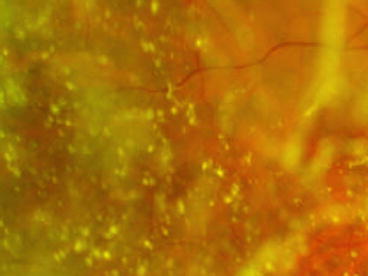(1)
St. Johns, FL, USA
(2)
Helen Keller Foundation for Research and Education, International Society of Ocular Trauma, Birmingham, AL, USA
(3)
Consultant and Vitreoretinal Surgeon, Milos Eye Hospital, Belgrade, Serbia
(4)
Consultant and Vitreoretinal Surgeon, Zagórskiego Eye Hospital, Cracow, Poland
46.1 General Considerations
Nontransparent material in the vitreous cavity casts a shadow on the retina; the closer the material to the tissue of vision, the more circumscribed (less fuzzy) the shadow. The visual disturbance is not objective; even more subjective is the way the individual’s brain processes it. Some people are bothered by a single, tiny floater; others do not recognize the presence even of those that the ophthalmologist can readily see at the slit lamp. Persons with synchysis scintillans (asteroid hyalosis) may have so many of these calcium or cholesterol bodies that the fundus is impossible to examine in fine detail (see Fig. 46.1), yet they do not complain and many of them decline surgery.


Fig. 46.1




Vitreous opacity interfering with fundus visualization. Why certain people, especially those with synchysis scintillans, are not bothered by floaters that actually prevent the ophthalmologist from seeing fine retinal details is rather mysterious
Stay updated, free articles. Join our Telegram channel

Full access? Get Clinical Tree


